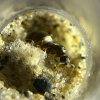Found about 5-6 of these guys under a rock in my backyard. First Formica i've ever seen in my backyard, and they seem to be either a slavemaking or moundmaking species, which is quite strange.
Approximately 6-8mm in length.

Keeping:
3x - S. molesta (colonies and single queen) 1x - C. nearcticus (founding but no eggs) ![]() New!
New!
1x - C. chromaiodes (colony) 1x - C. subbarbatus (founding)
1x - F. subsericea (founding) 1x - T. sessile (mega colony)
3x - P. imparis (colonies)
2x - L. neoniger (founding)
Check out my C. nearcticus journal here: https://www.formicul...cticus-journal/
Check out my C. chromaiodes journal here: https://www.formicul...aiodes-journal/
Formica sanguinea-group
Photos of the setae on the gula, occipital corners, and pronotum will allow for species identification.
0 members, 1 guests, 0 anonymous users